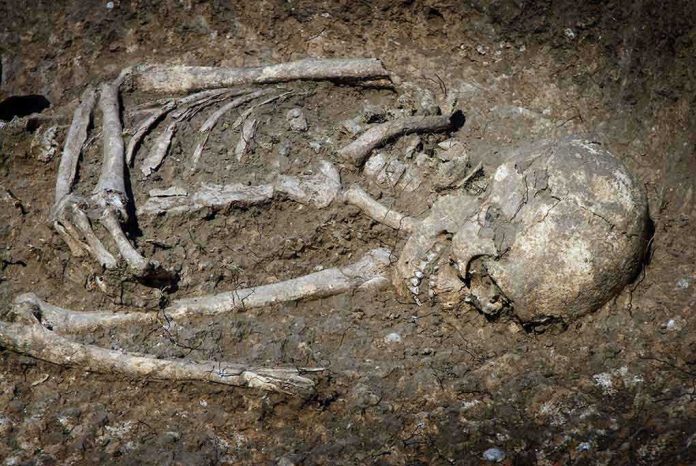
What if the most gripping murder mystery of the year wasn’t on the news, but buried beneath a Dorset field for 2,000 years—its silent witness finally brought to light by a tearful archaeologist and millions of TV viewers?
Story Snapshot
- An Iron Age teenage girl’s remains, showing signs of violence, were unearthed during the filming of Channel 4’s “Hidden Wonders.”
- Evidence suggests she was a victim of ritual human sacrifice, and her burial reveals rare matriarchal social structures in pre-Roman Britain.
- Sandi Toksvig’s emotional reaction on camera connects viewers to the human cost behind archaeological discoveries.
- This find rewrites the understanding of gender and ritual in ancient Britain, and could reshape how science and media collaborate.
Unearthing a 2,000-Year-Old Crime Scene in Front of the Cameras
Archaeologists rarely expect their discoveries to unfold before an audience, let alone spark tears. Yet, as Channel 4’s “Hidden Wonders” rolled cameras on a Dorset dig, they uncovered the skeleton of a teenage girl from the Durotriges tribe, her story sealed beneath the soil since before the Romans set foot in Britain. Trauma on her arms and torso, and the deliberate, face-down placement of her body in a pit, pointed toward a violent, ritualistic death. Could this be the clearest evidence yet of human sacrifice in Iron Age Britain, witnessed both by experts and the public in real time?
Lead archaeologist Dr. Miles Russell, working in concert with Bournemouth University, described the scene as a “murder mystery” unfolding under modern gaze. The girl’s burial was no ordinary farewell; it was an act charged with symbolism, authority, and perhaps even fear. The evidence: not just the wounds and unconventional posture, but the grave goods and settlement context. The presence of Roman artifacts at the site shows a collision of worlds—old tribal ways meeting the inexorable advance of empire. For a fleeting moment, ancient ritual and modern media intertwined, giving viewers a front-row seat to a drama that played out two millennia ago.
Television, Science, and the Power of Raw Emotion
Sandi Toksvig, known to many as a witty broadcaster, proved herself something more—an archaeologist emotionally invested in her work. Her hands cradled the ancient skull, and as she turned it to the light, the weight of centuries bore down. Toksvig confessed, “I could not stop crying.” Her tears were not for the cameras. They were for the lost girl, for the unknowable violence, and for the privilege of bearing witness. Toksvig’s reaction pierced the fourth wall, turning a cold case into a living tragedy and forcing the public to confront the humanity behind the headlines.
This scene, raw and unscripted, changed the tone of the broadcast. It also demonstrated that television, when paired with genuine discovery, can bridge the gap between scholarly detachment and universal empathy. Dr. Russell confirmed that Toksvig’s involvement was no celebrity stunt; her background in archaeology and anthropology lent legitimacy to the broadcast and deepened the sense of occasion. Channel 4, by blending entertainment with rigor, set a new standard for public science engagement—one that others may soon try to emulate.
Matriarchs, Rituals, and the Shifting Sands of British Prehistory
The skeleton’s secrets did not stop at the manner of her death. DNA analysis hinted at a revelation just as profound: the existence of matrilineal communities in Iron Age Britain. This is not just an academic footnote—it’s a direct challenge to long-standing assumptions that ancient British society was rigidly patriarchal. Dr. Russell called it “the first time that evidence of matrilineal communities have been documented in western European prehistory.” Such a claim, if supported by further research, could upend textbooks and ignite new debates about gender, power, and inheritance in the ancient world.
Ritual sacrifice, meanwhile, remains a contentious topic. Although bog bodies from elsewhere in Europe have long been interpreted as sacrificial victims, direct evidence from Britain is rare. The trauma on this girl’s body, her face-down burial, and the ceremonial context make a compelling case. Yet, as with all archaeology, alternative explanations—execution, warfare, or other rites—linger on the edges of certainty. The story’s power rests not just in answers, but in the enduring questions it raises about what ancient societies valued and feared.
From Local Discovery to Global Conversation
The Dorset community, once quietly sitting atop unremarkable pastures, now finds itself at the heart of a national conversation. The discovery is more than an academic footnote; it’s a flashpoint for debates about heritage, gender, and the role of ritual in society. Heritage tourism may soon follow, as visitors seek to stand where history was rewritten. For academics, the find is a call to reexamine other sites with fresh eyes—and to embrace the potential of media as a partner in public scholarship.
The story’s resonance lies in its complexity. A teenage girl lost to time, a team of scientists and broadcasters unraveling her fate, and a nation watching as ancient secrets rise to the surface. The tears shed in that Dorset field were not just for one lost soul, but for the countless untold stories that, with patience and a little luck, might yet see the light.






